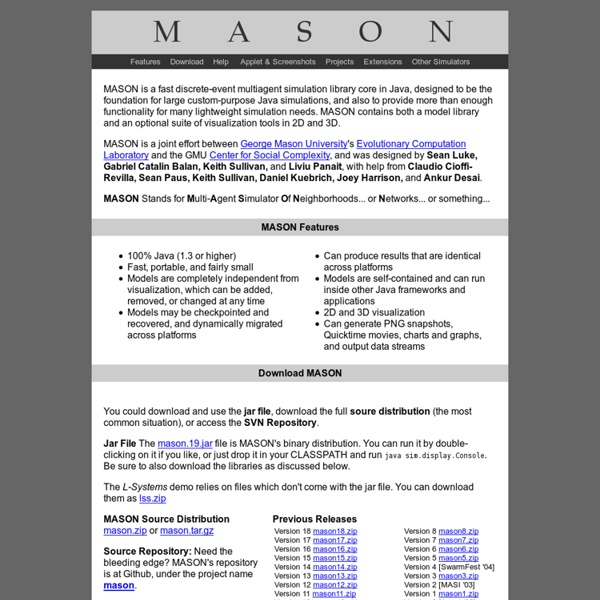



Ascape 5.6.0 Complex Systems Society : HomePage Photos of the PhD Session at Vienna Vienna , September 12-16, 2011 As one of the most important annual events in Complex Systems Science, the conference aims to provide a broad forum for the diverse communities engaged in Complex Systems research, ranging from the Life Sciences to Physics, from Computer Science to Social Science, from Mathematics to Origin of Life, and from Networks to Policy Implications. The ECCS'11 will feature a fine selection of inspiring keynote speakers , satellite conferences , awards , and panel discussions on a wide variety of hot topics. CSS has issued a new version of its community explorer with enhanced information about its members. All CSS members can appear in this living directory. Call for Abstracts - Deadline EMay 15th ASSYST / CSS March 2011 Newsletter During February, some interesting events took place, namely concerning Mathematics and Complex Systems Science. Download Now the March Newsletter ! European Future Technologies Conference and Exhibition
NetLogo Home Page NetLogo is a multi-agent programmable modeling environment. It is used by many hundreds of thousands of students, teachers, and researchers worldwide. It also powers HubNet participatory simulations. What can you do with NetLogo? Join mailing lists here. Download NetLogo Go to NetLogo Web NetLogo comes with a large library of sample models. JUNG - Java Universal Network/Graph Framework The Measuring Quality Inventory This web site provides an inventory of resources designed to assist higher education faculty and staff in the challenging task of assessing academic and support programs as well as institutional effectiveness, more broadly. The items in this inventory are divided into four categories: instruments (examinations, surveys, questionnaires, etc.); software tools and platforms; benchmarking systems and data resources; projects, initiatives and services. They can be searched using keywords or through a set of filters that include the unit of analysis, the targeted level of assessment, and the subject of measurement. This inventory is an update to the monograph, “Measuring Quality: Surveys and Other Assessments of College Quality” (Borden & Owens, 2001), published jointly by the American Council on Education and the Association for Institutional Research. The original volume included information about 26 assessment instruments (mostly examinations and surveys).
Centre for Research in Social Simulation - CRESS The Centre for Research in Social Simulation (CRESS), based in the Department of Sociology in the Faculty of Arts and Human Sciences at the University of Surrey, is a multidisciplinary centre bringing together the social sciences, software engineering and agent-based computing to promote and support the use of social simulation in research in the human sciences. There is growing interest in using computer simulation to explore issues in the social sciences. Simulation is a novel research method in most parts of the social sciences, including sociology, political science, economics, anthropology, geography, archaeology and linguistics. It can also be the inspiration for new, process-oriented theories of society. If you would like more information on CRESS research and activities, or to learn more about collaboration with CRESS, please email This e-mail address is being protected from spambots.
The Most Effective Factor in Education Weka 3 - Data Mining with Open Source Machine Learning Software in Java Weka is a collection of machine learning algorithms for data mining tasks. It contains tools for data preparation, classification, regression, clustering, association rules mining, and visualization. Found only on the islands of New Zealand, the Weka is a flightless bird with an inquisitive nature. The name is pronounced like this, and the bird sounds like this. Weka is open source software issued under the GNU General Public License. We have put together several free online courses that teach machine learning and data mining using Weka. Weka supports deep learning!
Gapminder: Unveiling the beauty of statistics for a fact based world view. Center for Complexity in Health at the Robert S. Morrison Health Sciences Building, Kent State University CIAO! | Cooperation & Interoperability – Architecture & Ontology Protovis Protovis composes custom views of data with simple marks such as bars and dots. Unlike low-level graphics libraries that quickly become tedious for visualization, Protovis defines marks through dynamic properties that encode data, allowing inheritance, scales and layouts to simplify construction. Protovis is free and open-source, provided under the BSD License. It uses JavaScript and SVG for web-native visualizations; no plugin required (though you will need a modern web browser)! Protovis is no longer under active development.The final release of Protovis was v3.3.1 (4.7 MB). This project was led by Mike Bostock and Jeff Heer of the Stanford Visualization Group, with significant help from Vadim Ogievetsky. Updates June 28, 2011 - Protovis is no longer under active development. September 17, 2010 - Release 3.3 is available on GitHub. May 28, 2010 - ZOMG! October 1, 2009 - Release 3.1 is available, including minor bug fixes. April 9, 2009 - First release on Google Code. Getting Started